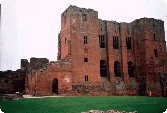 © 2001-2016 by Lise Hull
© 2001-2016 by Lise Hull
Openings for light in the castle tended to be either loops or windows. The loops did not provide an overall good view, and windows offered little protection for defenders. In the basement and first floor areas there were no windows and very few loops. The loops were provided with no closure, except maybe a thick curtain. The second and third floors would have had windows fitted with seats. The larger windows would be closed with wooden shutters or with parchment. The parchment would be made of oiled sheepskin or goatskin. Windows would also have been protected from intruders gaining entrance, or protection from missiles, by a external iron grill embedded into the masonry.
In the 11th century, windows above the first floor were about 4 feet high and 12 to 18 inches wide. The heads of the windows were either round or flat, and were splayed or set at the end of a tall, wide recess. What is meant by splayed? This is an opening which widens as it progresses inwards. These early windows did not let much light in, but provided good protection from incoming missiles.
By the late 12th century, windows became larger. Two openings were made to one internal recess with window seats. In later times of the 13th century, the oriel and lofty hall windows were developed. An oriel was like a nook, with a window and often times contained a fireplace. In the 14th century this developed into a delightful and aesthetically pleasing upper bay-window. An oriel was built by King Edward I at Stirling Castle in 1304 to provide his queen an observation area for a siege.

The origin of the invention of glass is lost. Sand of high silica content and a fluxing alkali (often soda or potash) are combined and heated to a high melting temperature. Throughout the middle ages the limited amounts of glass produced were crude in shape and quality of metal.
Glass was expensive, so it was rarely used in castle windows. Diamond (or "angled") mullions, which indicate a window without glass, were found from at least the 14th century, and were used for bedrooms, store rooms and other chambers until the late 17th. These windows usually had grooves for sliding shutters; some windows had hinged shutters.
In later periods, some castle upper hall windows contained glazing. From the late 16th century diamond mullions were gradually replaced by ovolo (or "sunk quadrant") mullions or by roll moulded mullions. Both types were used with glazed windows, some of which still retained sliding shutters. Glass was so valuable that it was removed from the windows and replaced by wooden shutters in the absence of the lord.
Glass was also heavily taxed, and this was not abolished until the 19th century. Some manor houses were fitted with window coverings made of animal horn, as this was a cheap alternative to glass. 12th century glass has been excavated at Ascot d'Oilly and Deddington castles.